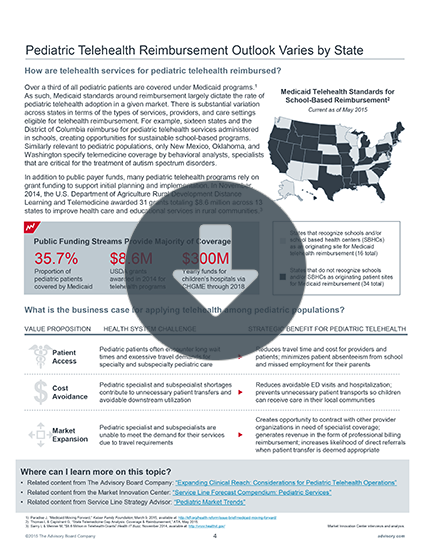Auto logout in seconds.
Continue LogoutWalt Disney last week announced a $100 million, five-year initiative to "transform the patient experience" at children's hospitals worldwide—beginning with Texas Children's Hospital.
Are you hitting your patient experience targets? Download our latest benchmarks to find out
Details of the plan
Robert Iger, chair and CEO of Disney, announced the plan at Texas Children's on Wednesday, saying, "Disney's timeless stories have touched hearts and lifted spirits for generations, and we believe they can bring comfort to children and families going through a very difficult time." He added that the company is planning to "transform the patient experience in children's hospitals around the world—creating a personalized and engaging atmosphere that will inspire young patients and ease the stress of a hospital stay."
According to Iger, Disney's "imagineers"—the company's experts in designing children and family entertainment at theme parks across the globe—will collaborate with a group of medical experts to integrate multiple Disney elements into the hospital experience. The group of medical experts, called "Team of Heroes," will include physicians, nurses, hospital administrators, child life professionals, patient care experts, and parents, ABC News reports.
Specific elements of the initiative may include:
- A system based on radio-frequency identification that allows patients to select their preferred Disney characters and narratives, which "will surround them during their stay," ABC News reports. The system would also tailor the patient experience in other ways, according to ABC News, "such as 'enchanted' artwork that comes alive";
- Patient rooms and treatment options themed around Disney stories. For instance, patient rooms may feature interactive Disney murals and themed bed linens and gowns, while families and patients would be able to access mobile "play carts" stocked with Disney games and activities;
- Personalized in-room entertainment, including first-run Disney movies and television shows that would also run in pop-up movie theaters within the hospital; and
- Customer-experience training for doctors, nurses, and staff from the Disney Institute. The Institute would create a customized program specifically for health care professionals "to foster a less stressful, patient and family-centric hospital experience," ABC News reports.
James Fahner—chief of the pediatric hematology and oncology division at Helen Devos Children's Hospital/Spectrum Health, and one of the medical experts consulting with Disney on the initiative—said of the plan, "Disney stories and characters provide a shared vocabulary between our young patients and their medical team." He added, "The magic of Disney restores some childhood innocence during a very difficult time, and also allows us as caregivers to be at our very best. I can't think of any company that is better suited to lead this type of work than Disney."
Texas Children's Hospital
Disney plans to test the initiative at Texas Children's to garner the hospital's insight on proposed experiences and new options, ABC News reports.
In announcing Disney's plans to collaborate with Texas Children's, Iger called the hospital a "global leade[r] in pediatric care as well as the largest children's hospital in the country," adding that its "dedicated healers share our commitment to support the emotional well-being of young patients and their families."
Mark Wallace, president and CEO of Texas Children's, added the hospital is "honored to be the inaugural hospital" for the initiative. "Patient care is at the center of our mission, and in addition to providing the highest-quality medical care to children, we strive to make the hospital experience as enjoyable and stress-free as possible for every patient and their family," he said. "We are looking forward to working with Disney to enhance our efforts in this area" (ABC13, 3/7; ABC News, 3/7; Najarro, Houston Chronicle, 3/7).
The case for improving coordination between behavioral health and pediatrics
The CDC estimates that nearly $247 billion is spent annually on the treatment and management of childhood mental disorders. Further, pediatric patients and caregivers often struggle to access high-quality behavioral health expertise due to a limited number of specialists and fragmented approaches to behavioral health services.
In this presentation, we review the case for improving coordination between behavioral health and pediatrics, and describe four successful models that increase access to behavioral health care.
Don't miss out on the latest Advisory Board insights
Create your free account to access 1 resource, including the latest research and webinars.
Want access without creating an account?
You have 1 free members-only resource remaining this month.
1 free members-only resources remaining
1 free members-only resources remaining
You've reached your limit of free insights
Become a member to access all of Advisory Board's resources, events, and experts
Never miss out on the latest innovative health care content tailored to you.
Benefits include:
You've reached your limit of free insights
Become a member to access all of Advisory Board's resources, events, and experts
Never miss out on the latest innovative health care content tailored to you.
Benefits include:
This content is available through your Curated Research partnership with Advisory Board. Click on ‘view this resource’ to read the full piece
Email ask@advisory.com to learn more
Click on ‘Become a Member’ to learn about the benefits of a Full-Access partnership with Advisory Board
Never miss out on the latest innovative health care content tailored to you.
Benefits Include:
This is for members only. Learn more.
Click on ‘Become a Member’ to learn about the benefits of a Full-Access partnership with Advisory Board
Never miss out on the latest innovative health care content tailored to you.

